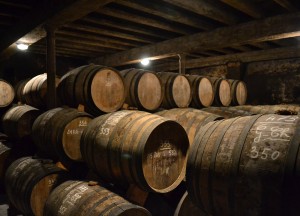Cognac, a renowned French spirit, is a type of brandy that has captivated the hearts and palates of people around the world. This exquisite drink is produced in the Cognac region of France and is made from grapes grown in specific areas designated as Appellation d’Origine Contrôlée (AOC). One of the most crucial aspects of the cognac-making process is the use of oak barrels for aging the spirit. In this article, we will delve into the significance of oak barrels in crafting cognac, the role of the wood in the aging process, and how it imparts unique flavors and aromas to the final product.
Cognac Oak
A cognac master blender has to mix a variety of eaux-de-vie that he thinks will best age together in oak barrels to make the perfect cognac. The oak barrels selected has a major impact on the color and taste of cognac. After all, the eaux-de-vie will be aged in barrels for two-100 years!
Barrels crafted for cognac aging are always made of oak. The oak, however, can be one of two types of oak Quercus pedunculata (sometimes known as q robur) or Quercus sessiliflora (sessile).
Quercus pedunculata
Quercus pedunculata accounts for about 20% of all trees in France and is harvested mostly in the Limousin forests near the city of Limoges, about 150 KM from Cognac. The soil in the Limousin forest is similar to that in the Cognac appellation – tending towards clay and limestone. The Quercus pedunculata is a porous wood and is very popular with master blenders. As a result of the porous nature of the wood, cognacs aged in Quercus pedunculata are more tannic than those aged in Quercus sessiliflora which has a tighter grain.
Rémy Martin cognac is aged in barrels with wood exclusively from the Limosin forest.
The Influence of Oak Barrels on Cognac’s Flavor and Aroma
Oak barrels have a significant impact on the flavor and aroma of cognac. As the spirit ages in the barrels, it extracts a variety of compounds from the wood, including vanillin, tannins, and lactones. These compounds contribute to the rich, complex flavor profile of the final product.
Vanillin, for example, imparts a subtle vanilla flavor to the cognac, while tannins provide structure and balance. Lactones, on the other hand, contribute to the fruity and floral aromas found in the spirit. The interaction between the eau-de-vie and the oak barrels also helps to mellow the harsh, fiery taste of the young spirit, transforming it into a smooth and refined drink. Cognacs aged in Quercus pedunculata have a smoky reddish color, with a woody taste, mixed with vanilla tones
Quercus sessiliflora
Quercus sessiliflora accounts for about 15% of all trees in France. Quercus sessiliflora trees are taller than Quercus pedunculata and have a less porous wood and therefore have less tannins. Quercus sessiliflora are harvested mainly in the Tronçais Forest in central France in the French Allier department. Cognacs aged in Quercus sessiliflora tend to be more amber than reddish in color and may have tones of coconut and spice.
Courvoissier VSOP is often aged in 200-year-old oak sourced from the Tronçais Forest.
Barrels for cognac aging generally come from oak trees that are 125-200 years old. The barrells are made from the first few meters of the tree only.
The Role of Oak Barrels in the Aging Process
The use of oak barrels in the aging process is an essential part of crafting cognac. After distillation, the young eau-de-vie is transferred to oak barrels for maturation. The wood plays a vital role in the development of the spirit’s character, as it imparts unique flavors and aromas while allowing the cognac to mellow and develop complexity over time.
The wood used for cognac barrels is predominantly French oak, sourced from the forests of Limousin and Tronçais. These oaks are known for their tight grain and high tannin content, which contributes to the distinctive taste and aroma of the final product. The barrels are typically toasted to varying degrees, which helps to release the wood’s natural sugars and flavors.
The Importance of Barrel Selection and Aging Conditions
The selection of oak barrels and the aging conditions play a crucial role in the development of a cognac’s flavor and aroma. Cognac producers carefully choose barrels with different levels of toasting and from different forests to achieve the desired flavor profile.
The aging conditions, such as temperature and humidity, also have a significant impact on the final product. In the humid cellars of the Cognac region, a portion of the spirit evaporates over time, a process known as the “angels’ share.” This loss of liquid concentrates the flavors and aromas in the remaining cognac, further enhancing its complexity.
The use of oak barrels in the crafting of cognac is a critical step that contributes to the spirit’s unique flavor and aroma. The wood imparts a range of flavors and aromas to the eau-de-vie, while the aging process allows the cognac to mellow and develop complexity over time. The selection of oak barrels and the aging conditions are crucial factors in shaping the final product, making the role of oak barrels in crafting cognac an indispensable part of the process.
Tips for Cognac Visitors
When visiting Cognac, consider a trip to the nearby Limousin forests near Limoges, where you can hike amid the mighty oak trees that provide Cognacs barrels.
Limousin Resources: http://www.tourismelimousin.com/
http://about-france.com/regions/limousin.htm
While in Cognac, a visit to a cooper to see how barrels are made is at the top of many visitors’ list.
Visit Tonnellerie Sansaud just outside cognac
Address: Route de Gensac, 16130 Segonzac, France
also try
Tonnellerie Vicard
Address: 184 Rue Haute de Crouin, 16100 Cognac, France
Oak Information Source: Cognac by Kyle Jarrard
